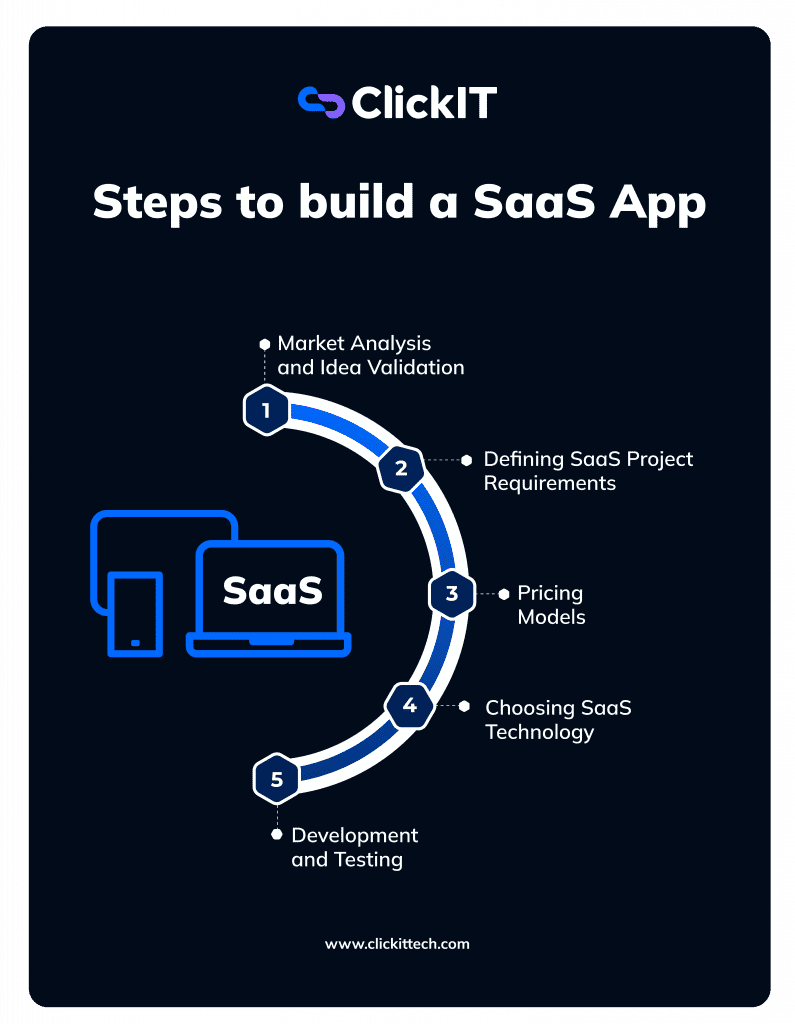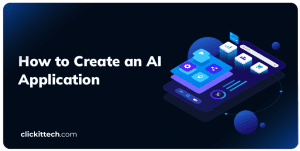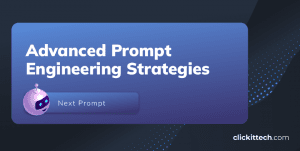SaaS, also known as Software as a Service, is a method of delivering applications through the internet as a form of service. Rather than using the old methods requiring installation and maintenance of the software, SaaS allows you to access the software easily through the Internet. But how to build a SaaS application? SaaS Development provides freedom from highly complex software and hardware management.
This blog will review the full process of developing a SaaS application; let’s get into it!
- Steps to Build a SaaS Development
- Conclusion of Building a SaaS Development
- Frequently Asked Questions About SaaS Development
The steps to take when building a SaaS app from scratch include:
- Market analysis and idea validation
- Defining your project requirements
- Choosing the right pricing model
- Building your ideal tech stack
- Developing your SaaS
- Testing and launching.
Let’s review the steps closely.
Steps to Build a SaaS Development
1. Market Analysis and Idea Validation
The first steps in creating a SaaS app are developing one and validating the concept by conducting in-depth market research.
Before building a SaaS app, it’s essential to pinpoint the value the project will bring to users. The app must meet certain of the client’s needs, which, in turn, will encourage them to pay for it regularly. Before pulling out the toolbox to build your SaaS app, you must identify and extensively study your target audience, focus on an industry, and choose the application type you’ll develop.
Choose your Industry for your SaaS Development
Selecting a target industry is key to its success when developing a SaaS application. Industries like FinTech, AI/ML, IoT, and healthcare each benefit from SaaS uniquely.
- In FinTech, SaaS offers cost savings, scalability, and enhanced data security.
- For AI/ML, SaaS streamlines processes like pattern recognition, providing personalized insights.
- In IoT and wearable tech, SaaS boosts data collection and real-time processing.
- In healthcare, SaaS improves patient care and helps healthcare professionals.
What are the Types of SaaS Solutions you can Develop?
Popular SaaS solutions include:
- CRM platforms, which enhance customer engagement and streamline data management for B2C companies
- Accounting software, which simplifies financial tasks for industries like retail and manufacturing.
- Project management tools boost team collaboration and tracking
- e-commerce solutions provide innovative features for setting up online stores easily.

2. Defining Your SaaS Project Requirements
The requirements include:
- Features
- Functionality
- Usability
- Additional security risks
- Potential reliability issues.
When building a SaaS app, these requirements must be considered and implemented to ensure the app’s usability and sustainability. The developer must also carefully consider the structured architecture of the app.
Also, developers can create the SaaS software development as a single-page, multi-page, multi-tenant or single-tenant. Each option has pros and cons, affecting the type of SaaS app developed.
In light of the above, you need a reliable cloud vendor to develop a SaaS app. Your development team must also consider the multi-tenancy issue. Several users accessing an app simultaneously create specific demands on the SaaS app architecture. Therefore, optimal system architecture must be in place for the SaaS app to endure all data being encrypted and backed up.
The web app design’s user interface (UI) and user experience (UX) are also critical and must be carefully considered.
Get a consultation to Build a SaaS application from scratch with ClickIT. Contact us
3. Developing a Robust Pricing Strategy
Most SaaS products use either subscription or freemium models. A subscription model offers different subscription plans with specific features included with specific subscription models.
With the freemium model, users can utilize basic features for free but must pay to access the advanced features. The basic features attract the users and allow them to get used to the app. Once they are accustomed to the services available on the platform, they will usually be more inclined to pay for premium features.
Other payment models available include flat rates, pay-per-user, pay-per-feature, usage-based pricing models, transaction fees, selling fees, and in-app advertising.
Read our blog, Top 6 SaaS Business Models.
4. Selecting the Optimal SaaS Technology Stack
Another critical aspect of developing a SaaS app is choosing the right tech stack. SaaS requires client-side (front-end), server-side, and database development. The back-end and cloud server deployment must also be considered. Several frameworks and tools can be chosen when building a SaaS app.
When selecting the right SaaS tech stack for the features you want on your app, an important aspect to consider is the scale of the app, the maturity of its technology and its integration with third-party systems.
For the front end, frameworks like React, Vue.js, or Angular are popular choices for creating responsive, user-friendly interfaces. On the back-end, languages such as Node.js, Python, or Java are often used to handle the server logic and API integration.
Regarding databases, options like MySQL, PostgreSQL, or MongoDB are chosen based on the type of data and the scale of operations. For cloud deployment, providers like AWS, Google Cloud, or Microsoft Azure offer scalable traffic and data storage solutions.
5. Development Process and Quality Assurance
Testing the SaaS application is necessary to work out any issues and ensure the app is perfect and ready for general use. A SaaS application is not built in the blink of an eye. Before the final product is released, it’s crucial to ensure the app is free of bugs and any issues to guarantee it’s ready for general use.
As a last step for creating a SaaS application, considering a Minimum Viable Product (MVP) can be the right decision. An MVP only includes the application’s essential features, which meet the target audience’s basic needs. This will receive feedback from first adopters, which will help provide a springboard for adjustments, corrections, and improvements.
Once feedback is gathered from early adopters, the development team can implement adjustments, corrections, and feature enhancements based on real-world usage. Alongside unit tests and functional tests, quality assurance can involve load testing, security testing, and performance tuning to ensure that the application performs well under stress, is scalable, and secure enough to handle sensitive user data.
The SaaS application evolves steadily through this iterative development process while maintaining high-quality standards, driven by user insights and a robust QA approach.

Conclusion of Building a SaaS Development
Building a great SaaS application requires time, dedication, and technical know-how. In light of the complexities involved, working with a team that understands what constitutes a good SaaS application is often a great idea. The team should appreciate your opinion and understand your vision for things to run smoothly.
The features you want on your SaaS application determine the number and roles of developers you need to build your team. Before heading into the development phase, you should speak with a SaaS software development agency that understands the intricacies of developing a SaaS application. This way, you can create an outstanding team that can address all of the essential features of your app.
If you want to develop a SaaS application, ClickIT is the best DevOps team to assist you with top SaaS development services. We help build high-quality applications that suit the needs and desires of our clients to the T.
Frequently Asked Questions About SaaS Development
SaaS development is the process of creating software applications that are hosted online and delivered to users via the Internet. This model allows users to access software from any device with an internet connection without needing to install or maintain the software themselves.
To create a SaaS, start by identifying a market need and researching a problem your SaaS will solve. Next, plan and design the features and user interface, creating a development roadmap. Develop the software using appropriate programming languages and frameworks and conduct thorough testing to ensure it is bug-free and user-friendly.
Finally, deploy and launch your SaaS by hosting it on a reliable server, setting up a domain, and making it available to users. Continuous monitoring, maintenance, and updates are essential to fix bugs, improve functionality, and ensure security.
It takes about three to nine months to develop a SaaS application. The time varies depending on complexity, features to be included, and the number of stages required before launching.










